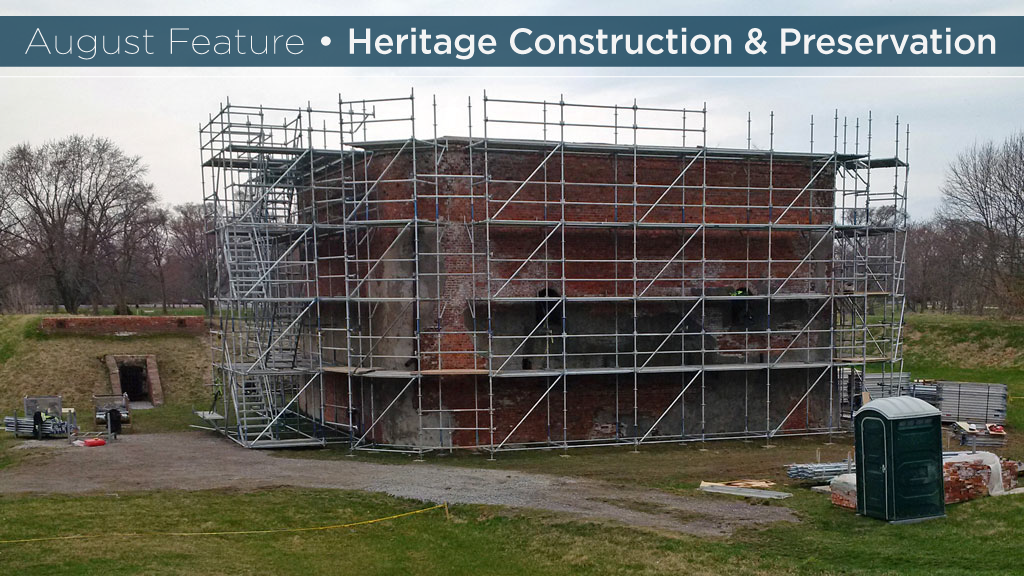Fort Mississauga in Niagara-on-the-Lake, Ont. served for years as an imposing military presence against U.S. forces. As a national historic site, heritage conservationists are fighting a new and protracted battle today against the moisture that once threatened to buckle its walls.
Built between 1814 and 1816, Fort Mississauga was constructed as a counterpoint to America’s Fort Niagara across the Niagara River, visible to the naked eye. The fort was constructed with a 25-foot central tower, barracks and guardroom protected by unique star-shaped earthworks.
A massive “hot shot” cannon mounted on the roof of the tower could fire super-heated cannonballs that would ignite any wooden target they struck.
However, the fort was originally intended to serve only as a “protective bastion” to construct an expanded fort that was never built — what would have been the largest fort in Canada.
Active through the American Civil War and the Fenian Raids, the fort ceased to serve a military purpose by 1870.
Although it was used at times as a military training facility over the next century, what remains today is the fort’s earthworks and central tower, located near the first hole of the historic Niagara-on-the-Lake nine-hole golf course.
Restoration of Fort Mississauga began in 2019 under a $7.3-million federal infrastructure grant. Work completed over two years included re-establishing the earthworks surrounding the fort, replacing the roof, stabilizing the central tower, construction of a new, wooden pedestrian boardwalk, and restoration of two bulk powder magazines and the “sally port,” a narrow, fortified tunnel that allowed soldiers to receive supplies from the waterfront. As a bonus, stealth solar panels were also installed to make this the only solar-powered fort in the federal system.
A second $4.9-million federal program funded the ongoing stabilization of the shoreline, which had been compromised due to high lake levels.
Chris Zoetewey, technical services officer with Parks Canada, notes builders of the time were active recyclers of construction material.
“It’s historically documented that the first 10 feet of the building is constructed from the reclaimed brick of the town of Niagara-on-the-Lake, which was burned to the ground when American troops retreated to the other side during December 1813,” he says. “With no local brickworks, engineers saw their opportunity to start building Fort Mississauga right away.”

The tower walls are 2.8 metres thick and filled with limestone rubble, designed to absorb the impact of cannonballs. That fill material was likely derived from limestone scrap that once formed the structure of a nearby lighthouse, Upper Canada’s first.
“The tops of the walls formed a gun deck, but that developed leaks and all of that water was draining into the rubble fill,” Zoetewey says. “Freeze-thaw cycles were actually deforming the exterior wall.”
The first round of historic improvements concentrated on the tower, in part to ensure that no new moisture entered the building. Contractors stabilized much of the brick wall, including brick replacements and repointing and a new roof with a drip edge was also installed.
Examining how much water remained inside the walls, construction crews removed an area measuring four-by-four bricks and two bricks deep to reach the limestone rubble fill.
“Water poured out of that opening for a good six or seven hours,” Zoetewey says. “We estimate that the water between the walls probably measured two to three metres deep.”
The tower work was completed in November 2021 and the project received an award of excellence in conservation engineering from the Canadian Association of Heritage Professionals.
Ongoing shoreline stabilization and protection efforts continue, but anticipating the next phase of architectural restoration echoes the words of poet John Milton: “They also serve who only stand and wait.”
Even with additional air circulation improvements, Zoetewey estimates conservationists will have to stand by for some time to come. The walls will require from five to 10 years to dry out before restoration work can resume.
“If we jump the gun and go in directly to fix it all before letting the water naturally drain out, we’re going to be back at it in a very short time,” he says.



Recent Comments